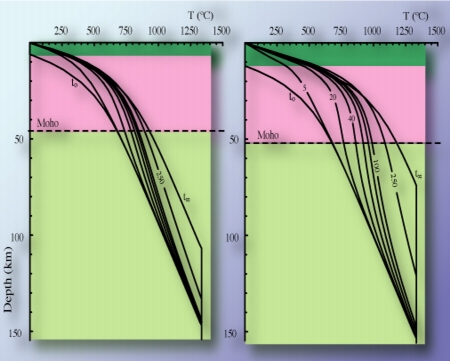|
Sedimentation of burial of the crust
Sedimentation and burial of the continental crust under a few kilometre of volcano-sedimentary rocks have a significant long-term effect on the geotherm. The newly deposited layer effectively insulates the heat producing layer. If the conductivity of the upper layer is lower or equal to that of the buried layer, then heat accumulates increasing the geotherm.
This effect could have played a major role in the differentiation of the continental crust in the Archaean. At that time, radiogenic heat production in the crust was 2 to 6 time larger that of present day rate of radiogenic heat production in the continental crust. Furthermore it was a time when 5 to 15 km thick continental flood basalts (the so called greenstones) where deposited at the surface of the Earth, insulating the heat producing Earth's crust.
The graphs on the right show transient geotherms following the emplacement of a 6 km (graph on the left) and 12 km thick greenstone covers, with no radiogenic heat production in them. The temperature increase is large enough to lead to profound partial melting in the crust.
Learn more by reading the following paper: Rey et al, 2003
|
